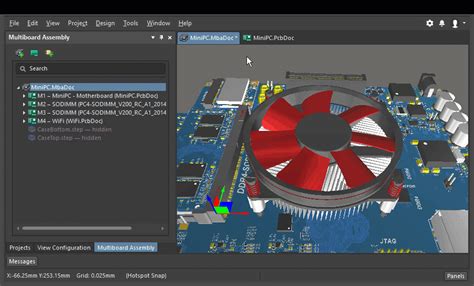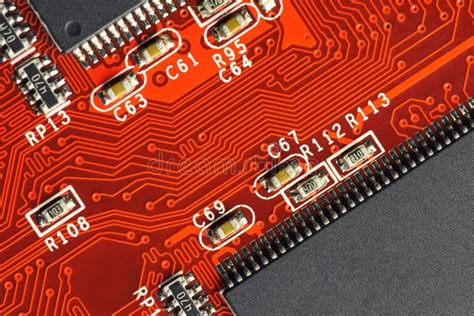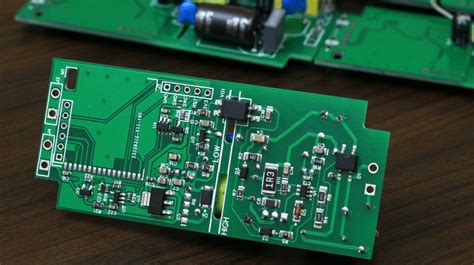Mastering Altium Multiboard Assembly: A Comprehensive Guide
Key Takeaways
Understanding Altium Multiboard Assembly is crucial for those engaged in printed circuit board (PCB) design, as it encompasses vital aspects of pcb assembly and effective collaboration across team members. One of the key takeaways from mastering this technique is the importance of integrating multiple pcba setups into a cohesive workflow. This not only enhances the productivity of each design phase but also minimizes potential errors during assembly. Leveraging advanced techniques and best practices in your workflow can lead to smoother interactions among different board designs, reducing both time and cost associated with revisions and prototyping. Furthermore, knowing how to utilize Altium’s built-in features can greatly assist in streamlining processes, making the transition between different boards seamless. It’s essential for teams to recognize common challenges faced during multiboard projects and proactively seek useful solutions that encourage a more effective assembly environment. By applying these insights, designers at all skill levels can significantly boost their project outputs and ensure high-quality results throughout their pcb assembly endeavors.
Introduction to Altium Multiboard Assembly
Altium Multiboard Assembly is a pivotal methodology in the world of PCB assembly that allows designers and engineers to create complex electronic systems with enhanced efficiency and accuracy. This process involves the collaboration of multiple printed circuit boards (PCBs) within a single project, offering a comprehensive solution for developing intricate designs that demand precision. Understanding the nuances of multiboard design is essential for successfully executing any project, as it facilitates effective communication among team members and optimizes the overall workflow. By leveraging features unique to Altium, teams can streamline their PCBA processes and tackle potential challenges with confidence. As we delve deeper into this guide, we will explore key concepts, best practices, and advanced techniques that not only enhance design collaboration but also significantly boost productivity. Whether you are an industry veteran or a newcomer to the field, mastering Altium Multiboard Assembly will empower you to deliver superior electronic products that meet the complex demands of today’s technology landscape.
Key Concepts in Multiboard Design
Understanding the key concepts in multiboard design is essential for engineers and designers involved in pcb assembly processes. The intricacies of multiboard systems often demand careful consideration of how separate printed circuit boards (PCBs) interact within a larger project. One crucial aspect is the interface between boards, as effective communication and signal integrity between pcba components can significantly impact the overall functionality of a device. Moreover, designers need to embrace the principle of modularization, which allows for easier troubleshooting and upgrades in complex systems. Managing electrical and mechanical aspects through proper connections, such as flexible or rigid connectors, is vital to ensure robust assembly. Additionally, simulation tools integrated within Altium can greatly aid in visualizing how different boards will operate together, reducing errors before physical prototypes are created. By addressing these foundational aspects early in the design phase, teams can streamline their assembly processes and enhance project outcomes through effective collaboration. Adopting these principles not only leads to more reliable products but also optimizes resources during the assembly phase of development.
Best Practices for Effective Collaboration
Effective collaboration is crucial in the realm of Altium Multiboard Assembly, ensuring that all team members seamlessly integrate their efforts to achieve optimal outcomes. To facilitate successful collaboration, it’s essential to establish clear communication channels among all stakeholders involved in the PCB assembly process. Encouraging regular meetings and updates can help address any issues promptly and maintain project momentum.
One best practice is to adopt a centralized project management tool that provides visibility into each stage of the PCBA process. This makes it easier for teammates to track progress, share insights, and identify potential bottlenecks. Utilizing such tools not only enhances communication but also fosters a culture of transparency and accountability among team members.
Furthermore, it is recommended to create detailed documentation that outlines design specifications and standards. By standardizing workflows and ensuring that all contributors understand the expectations, teams can work more effectively towards a common goal. Utilizing version control systems can also prevent miscommunication regarding design changes.
| Collaboration Aspect | Best Practice |
|---|---|
| Communication | Establish clear channels for regular updates |
| Project Management | Use centralized tools for tracking progress |
| Documentation | Maintain thorough documentation of design specifications |
| Workflow Standardization | Standardize workflows for clarity and efficiency |
In addition to these strategies, it’s important to encourage an environment where team members feel comfortable sharing their ideas and concerns. A collaborative atmosphere not only sparks creativity but also enables individuals to learn from one another, ultimately contributing to a higher quality of work in multiboard assembly projects.
By incorporating these best practices into your workflow, you can significantly enhance collaboration efficiency, leading your team towards successfully navigating the complexities of Altium Multiboard Assembly while achieving impressive results in your PCBA endeavors.
Advanced Techniques for Streamlining Assembly Processes
In the realm of Altium Multiboard Assembly, the efficiency of pcb assembly processes can significantly impact project timelines and quality. One advanced technique to streamline assembly is the integration of automation tools within the design workflow. By leveraging features such as automatic placement and routing, designers can minimize manual adjustments and reduce errors during pcba. Moreover, adopting a cohesive project management platform encourages real-time communication among team members, ensuring that everyone is aligned on design changes and assembly procedures.
It is also beneficial to conduct regular design reviews and virtual assemblies to identify potential issues early in the process. This proactive approach not only saves time but also enhances the overall quality of the assembled product. As a tip, consider using simulation tools to visualize how components will interact during pcb assembly, which can lead to more informed design decisions.
“Efficiency in multiboard projects arises from a deep understanding of both design intent and production capabilities.”
Finally, keeping abreast of the latest advancements in manufacturing technologies and materials can provide insights into how to optimize your pcba processes further. Implementing these advanced techniques will not only streamline your assembly process but also enhance collaboration across teams, ultimately driving productivity and success in your multiboard projects.
Common Challenges and Solutions in Multiboard Projects
In the world of multiboard projects, several challenges may arise that can hinder the efficiency of your pcb assembly processes. One common issue is synchronization, particularly when multiple designers are working on separate boards that need to interface seamlessly. To tackle this, implementing a robust version control system can ensure that changes are tracked and merged effectively, preventing conflicts and confusion during the pcba phase.
Another challenge is the management of component libraries across different boards. Discrepancies in component footprints can lead to complications during assembly. A practical solution is to maintain a centralized library that all team members access, accompanied by regular audits to ensure consistency. Furthermore, utilizing Altium’s features for cross-referencing components can streamline the integration of different boards.
Communication is key in any collaborative environment, yet with various stakeholders involved, misunderstandings may occur. Establishing clear channels for updates—such as shared project management tools—can promote transparency and facilitate timely feedback, thus enhancing overall project coordination.
Lastly, testing and validation of the overall assembly can prove complex due to the interdependencies among multiple boards. Employing simulation tools provided by Altium allows designers to identify issues early in the design phase, significantly reducing troubleshooting time during assembly completion. By being aware of these challenges and implementing strategic solutions, you can enhance productivity and ensure smoother workflows in your multiboard projects.
Enhancing Productivity with Altium Features
Harnessing the full potential of Altium Multiboard Assembly can significantly enhance the productivity of your PCB projects. One of the standout features of Altium is its ability to facilitate collaborative design, allowing multiple team members to work simultaneously on different components of a project. This is particularly beneficial in complex designs where various PCB assemblies (PCBA) are involved, as it minimizes potential errors and accelerates the development cycle.
Additionally, Altium offers robust tools for real-time visualization and verification, which serve to streamline the assembly process. By enabling designers to spot inconsistencies early on, these features reduce the time spent in revisions, ultimately leading to faster time-to-market. The integration of advanced simulation tools further enhances productivity by allowing designers to test their assemblies virtually before physical prototypes are made.
Moreover, utilizing Altium’s extensive library management can significantly reduce individual workload by providing access to a vast array of predefined components and designs, which can be utilized across multiple projects. This not only saves time but also ensures consistency across various multiboard projects.
In summary, leveraging these features within Altium enables users to optimize their workflow effectively, ensuring that both design integrity and productivity are maintained throughout the assembly process.
Case Studies: Successful Multiboard Projects
When examining pcb assembly projects, case studies often reveal valuable lessons and showcase best practices that can significantly enhance the success of future endeavors. One standout example is a recent project involving a collaborative team that utilized Altium Multiboard Assembly to streamline the assembly process. This project, which involved multiple boards interconnected in a complex system, highlighted how effective communication strategies and thorough planning can prevent common pitfalls associated with pcba tasks.
The team began with a detailed design phase, ensuring that each board was compatible with the others. Through regular meetings, they maintained clear channels of communication, allowing for quick adjustments based on feedback and design challenges. By leveraging Altium’s features, they were able to utilize automated design rule checks and simulation tools to identify potential issues early in the process. This proactive approach not only saved time but also significantly reduced errors during the assembly phase.
Another noteworthy case involved a mixed-signal application where proper alignment of analog and digital components was critical. In this instance, meticulous attention to the layout in each board ensured that electromagnetic interference was minimized. The team’s use of Altium‘s advanced filtering options allowed them to optimize signal integrity across boards effectively, leading to enhanced product performance.
Through these examples, it becomes clear that mastering Altium Multiboard Assembly is not just about understanding software tools but also about fostering collaboration and strategic planning among team members. By drawing on these case studies, engineers can apply learned strategies to their own projects, ensuring smoother workflows and higher-quality outcomes in their pcb assembly processes.
Conclusion and Future Trends in Multiboard Assembly
As we look towards the future of Altium Multiboard Assembly, several emerging trends and technologies are poised to revolutionize the process of pcb assembly. With the continuous advancement in pcba technologies, it is vital to stay updated on tools and methods designed to enhance efficiency and accuracy. For instance, the integration of AI-driven design tools is streamlining the assembly processes, allowing engineers to reduce human error and minimize time spent on revisions. Moreover, collaboration among teams has become increasingly sophisticated, thanks to cloud-based platforms that facilitate real-time feedback and version control. This collaborative approach not only enhances workflow but also fosters creativity, leading to more innovative designs. Additionally, as sustainability becomes a priority across industries, multiboard assembly is expected to evolve with eco-friendly materials and manufacturing practices at its core. These trends indicate a promising future for professionals engaged in pcb assembly, ensuring that they remain competitive by adopting new technologies that enhance productivity while addressing environmental concerns.
Conclusion
In sum, mastering Altium Multiboard Assembly requires a deep understanding of various pcb assembly techniques and effective collaboration strategies. As you progress through your projects, it’s essential to apply the best practices outlined to overcome common challenges and streamline your processes. The use of advanced tools within Altium can significantly enhance productivity by simplifying complex pcba workflows. Moreover, embracing a proactive approach to learning from past projects through case studies will prepare you for future trends in multiboard design technology. Staying updated on these trends not only fosters innovation but also positions you as a leader in the multiboard assembly field. The journey towards enhanced assembly efficiency is ongoing, and cultivating a robust skill set will yield fruitful results in your electronic design initiatives.
FAQs
What is Altium Multiboard Assembly?
Altium Multiboard Assembly refers to the process of designing and assembling multiple printed circuit boards (PCBs) that work together within a single project. This method significantly enhances the functionality and efficiency of complex electronic systems.
How does Altium support PCB assembly?
Altium provides an extensive suite of tools that facilitate pcb assembly through streamlined design workflows and collaborative features. Its intuitive interface allows users to design, simulate, and fabricate multi-board setups effectively.
What are common challenges in multiboard projects?
Some common challenges include coordinating the design among multiple boards, ensuring signal integrity, and managing power distribution. These issues can often be overcome with effective pcba practices and thorough planning.
What are the best practices for successful multiboard design?
Best practices include consistent naming conventions for components, regular communication among team members, and rigorous testing at each stage of development. Implementing these strategies helps mitigate potential issues during pcb assembly.
How can productivity be enhanced with Altium?
Utilizing features such as automated routing, design rule checks, and real-time collaboration tools can significantly enhance productivity. These elements enable quicker iterations and a more efficient workflow in pcba processes.







